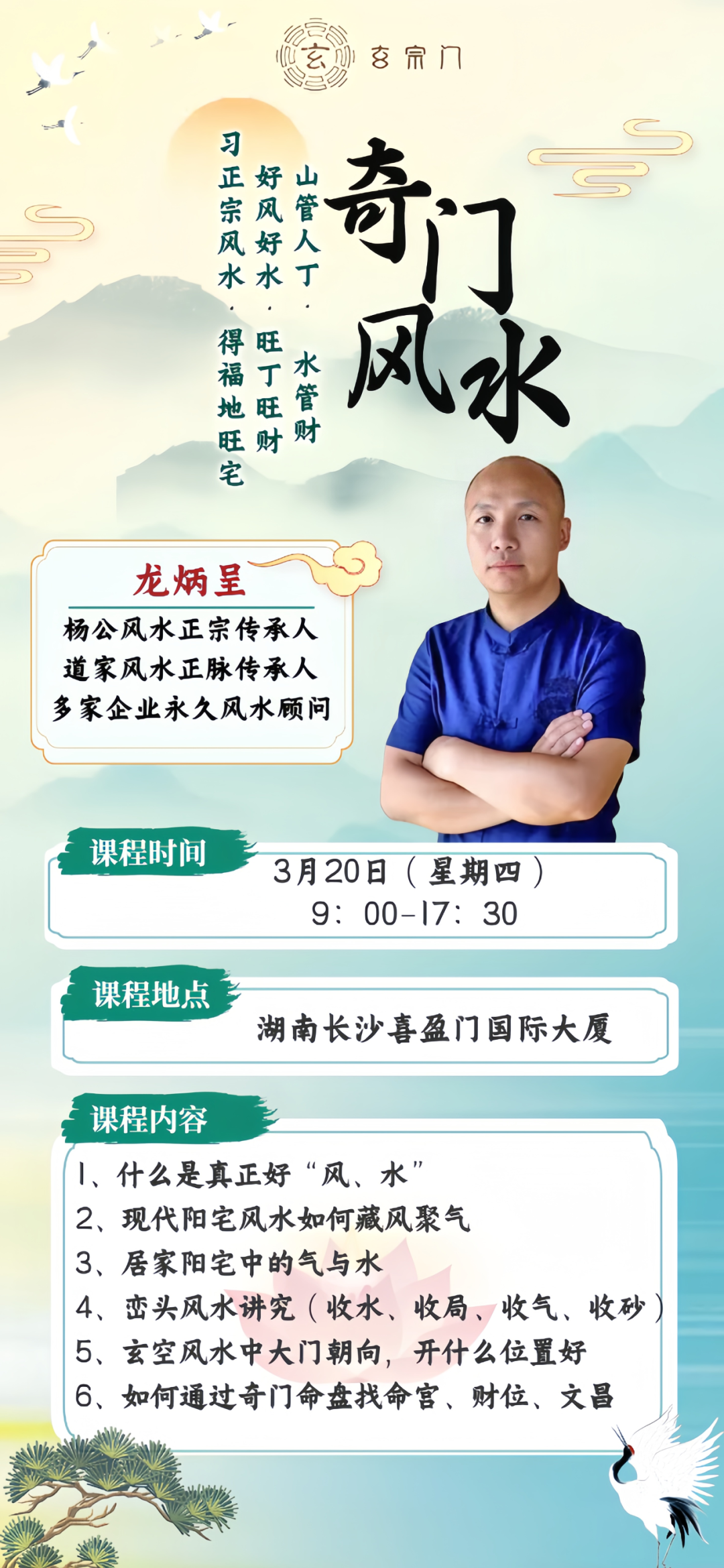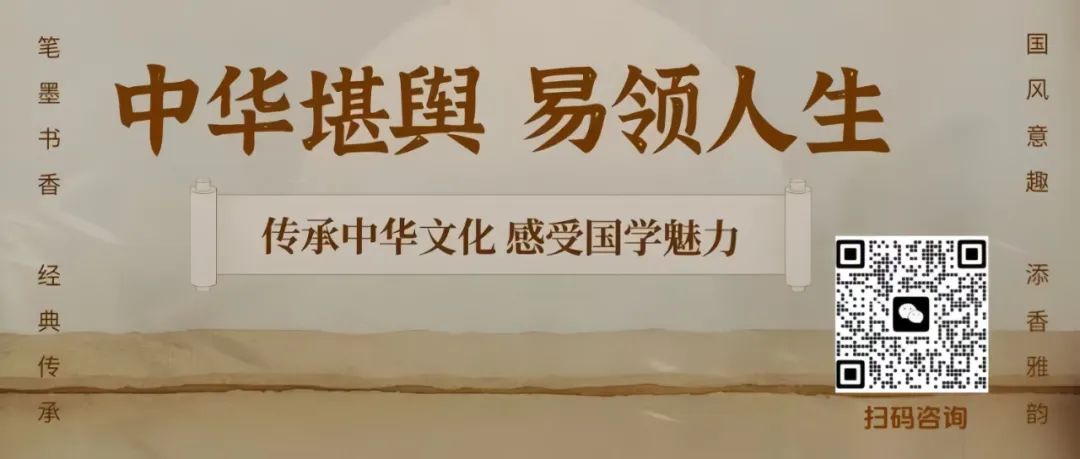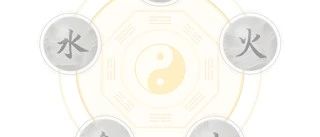
The generative sequence of the Five Elements is: Metal generates Water, Water generates Wood, Wood generates Fire, Fire generates Earth, Earth generates Metal.
The restrictive sequence of the Five Elements is:Metal restrains Wood, Wood restrains Earth, Earth restrains Water, Water restrains Fire, Fire restrains Metal.
Generative Relationships of the Five Elements:
Metal generates Water: Metal melts to produce Water; Water generates Wood: Water nourishes to produce Wood; Wood generates Fire: Wood is warm and generates Fire; Fire generates Earth: Fire burns Wood to produce Ash, which is Earth; Earth generates Metal: Earth contains minerals that produce Metal.
Meaning of Generative Relationships:Metal generates Water—because the subtle Yin energy (Metal energy) is warm and flows, Metal relies on Water to be born; melted Metal can also turn into Water, hence Metal generates Water. Water generates Wood—because Water is moist and allows trees to grow, thus Water generates Wood.Wood generates Fire—because Wood is warm, Fire is hidden within, and Fire is generated by drilling Wood, hence Wood generates Fire. Fire generates Earth—because Fire is hot, it can burn Wood, and when Wood is burned, it turns to Ash, which is Earth, thus Fire generates Earth. Earth generates Metal—because Metal needs to be hidden in rocks, attached to mountains, nourished to grow, and when Earth accumulates, it forms mountains, which must contain stones, hence Earth generates Metal.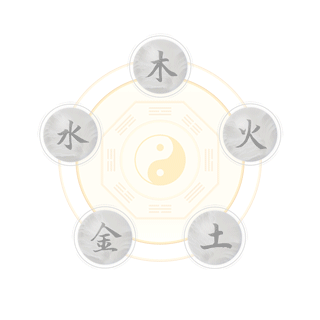 Restrictive Relationships of the Five Elements:Metal restrains Wood, Wood restrains Earth, Earth restrains Water, Water restrains Fire, Fire restrains Metal.Meaning of Restrictive Relationships: This is due to the nature of Heaven and Earth where the many overcome the few, hence Water overcomes Fire; the subtle overcomes the firm, hence Fire overcomes Metal; the hard overcomes the soft, hence Metal overcomes Wood; the concentrated overcomes the dispersed, hence Wood overcomes Earth; the substantial overcomes the void, hence Earth overcomes Water.The hard overcomes the soft, hence Metal overcomes Wood; because tools can cut down trees;The concentrated overcomes the dispersed, hence Wood overcomes Earth; because trees can stabilize collapsing soil;The substantial overcomes the void, hence Earth overcomes Water; because dams can stop water flow;The many overcome the few, hence Water overcomes Fire; because a flood can extinguish flames;The subtle overcomes the firm, hence Fire overcomes Metal; because intense fire can melt metals.Metal can generate Water, but too much Water sinks Metal; Water can generate Wood, but too much Wood shrinks Water; Wood can generate Fire, but too much Fire burns Wood; Fire can generate Earth, but too much Earth obscures Fire; Earth can generate Metal, but too much Metal weakens Earth.Metal can restrain Wood, but too much Wood breaks Metal; Wood can restrain Earth, but too much Earth bends Wood; Earth can restrain Water, but too much Water washes away Earth; Water can restrain Fire, but too much Fire scorches Water;Fire can restrain Metal, but too much Metal extinguishes Fire.When Metal is weak and encounters Fire, it will surely melt; when Fire is weak and encounters Water, it will surely extinguish; when Water is weak and encounters Earth, it will surely be blocked; when Earth is weak and encounters Wood, it will surely collapse; when Wood is weak and encounters Metal, it will surely be cut.Strong Metal needs Water to temper its edge; strong Water needs Wood to ease its flow; strong Wood needs Fire to release its essence; strong Fire needs Earth to contain its flame; strong Earth needs Metal to transform its stubbornness.
Restrictive Relationships of the Five Elements:Metal restrains Wood, Wood restrains Earth, Earth restrains Water, Water restrains Fire, Fire restrains Metal.Meaning of Restrictive Relationships: This is due to the nature of Heaven and Earth where the many overcome the few, hence Water overcomes Fire; the subtle overcomes the firm, hence Fire overcomes Metal; the hard overcomes the soft, hence Metal overcomes Wood; the concentrated overcomes the dispersed, hence Wood overcomes Earth; the substantial overcomes the void, hence Earth overcomes Water.The hard overcomes the soft, hence Metal overcomes Wood; because tools can cut down trees;The concentrated overcomes the dispersed, hence Wood overcomes Earth; because trees can stabilize collapsing soil;The substantial overcomes the void, hence Earth overcomes Water; because dams can stop water flow;The many overcome the few, hence Water overcomes Fire; because a flood can extinguish flames;The subtle overcomes the firm, hence Fire overcomes Metal; because intense fire can melt metals.Metal can generate Water, but too much Water sinks Metal; Water can generate Wood, but too much Wood shrinks Water; Wood can generate Fire, but too much Fire burns Wood; Fire can generate Earth, but too much Earth obscures Fire; Earth can generate Metal, but too much Metal weakens Earth.Metal can restrain Wood, but too much Wood breaks Metal; Wood can restrain Earth, but too much Earth bends Wood; Earth can restrain Water, but too much Water washes away Earth; Water can restrain Fire, but too much Fire scorches Water;Fire can restrain Metal, but too much Metal extinguishes Fire.When Metal is weak and encounters Fire, it will surely melt; when Fire is weak and encounters Water, it will surely extinguish; when Water is weak and encounters Earth, it will surely be blocked; when Earth is weak and encounters Wood, it will surely collapse; when Wood is weak and encounters Metal, it will surely be cut.Strong Metal needs Water to temper its edge; strong Water needs Wood to ease its flow; strong Wood needs Fire to release its essence; strong Fire needs Earth to contain its flame; strong Earth needs Metal to transform its stubbornness.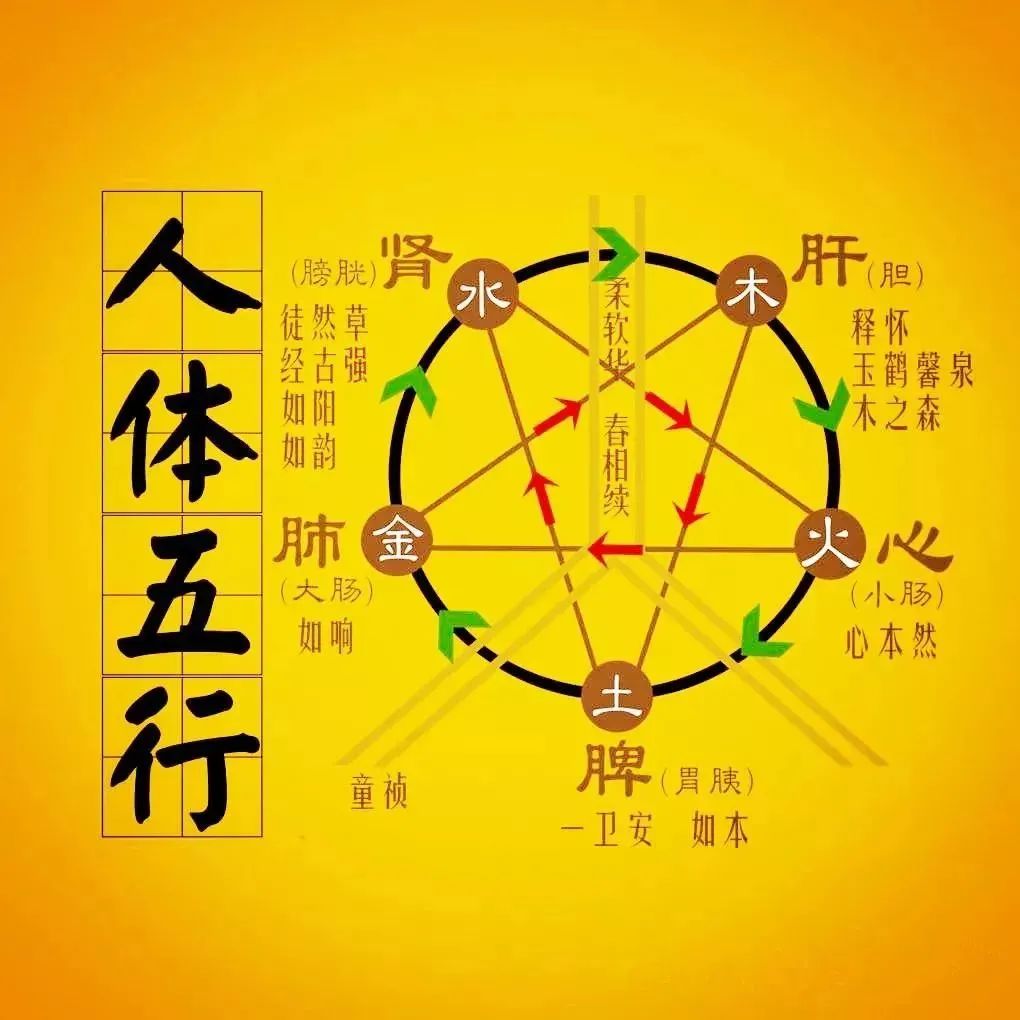 Correspondence of the Five Elements with the Human BodyThe Five Elements are Wood, Fire, Earth, Metal, and Water, representing five attributes, which are abstract concepts and should not be understood as specific entities. Five is a universal number, as seen in five fingers, five senses, five organs, five tastes… many things can be categorized into five types.In Traditional Chinese Medicine (TCM), the Five Elements describe the functions and relationships of the five organ systems (Liver, Heart, Spleen, Lung, Kidney), noting that these organs also represent functional concepts (known as zangxiang) and are not limited to the specific anatomical organs.Wood—growth, flexibility, gentleness, smoothnessFire—warmth, rising, brightnessEarth—transformation, support, acceptanceMetal—cleansing, purification, convergenceWater—coolness, nourishment, downward movement
Correspondence of the Five Elements with the Human BodyThe Five Elements are Wood, Fire, Earth, Metal, and Water, representing five attributes, which are abstract concepts and should not be understood as specific entities. Five is a universal number, as seen in five fingers, five senses, five organs, five tastes… many things can be categorized into five types.In Traditional Chinese Medicine (TCM), the Five Elements describe the functions and relationships of the five organ systems (Liver, Heart, Spleen, Lung, Kidney), noting that these organs also represent functional concepts (known as zangxiang) and are not limited to the specific anatomical organs.Wood—growth, flexibility, gentleness, smoothnessFire—warmth, rising, brightnessEarth—transformation, support, acceptanceMetal—cleansing, purification, convergenceWater—coolness, nourishment, downward movement
Entities within the same element interact with each other, but excess can be harmful. For example, anger harms the Liver. The case of Fan Jinzhongju is a typical example of excessive joy harming the Heart. Similarly, an appropriate amount of sweetness can nourish the Spleen, but excessive sweetness can stagnate the Spleen.
The Generative and Restrictive Relationships of the Five Elements
Generative relationships refer to one entity promoting, assisting, and nurturing another entity (for convenience of discussion, the generative entity is called the mother, and the generated entity is called the child). Restrictive relationships refer to one entity inhibiting and constraining the growth and function of another entity. Generative and restrictive relationships are normal phenomena that exist universally in nature. Without generation, there is no development; without restriction, there is excess that can cause harm. Both are important; do not think that generation is good and restriction is bad.Gigantism is a case of growth lacking restraint.Generative and restrictive relationships are inseparable aspects. Without generation, there is no occurrence and growth of entities; without restriction, there cannot be balance and coordination in the development and changes of entities.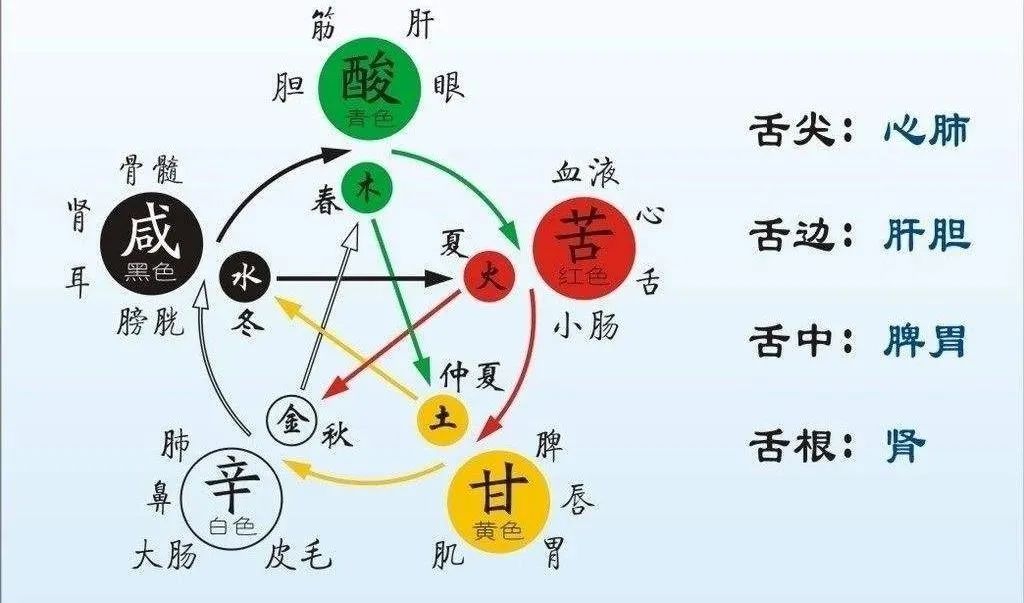 Relationships Among the Five Organs(1) Generative relationships among the Five Organs: The Liver generates the Heart, which is Wood generating Fire, as the Liver stores Blood to nourish the Heart; the Heart generates the Spleen, which is Fire generating Earth, as the Yang energy of the Heart can assist the Spleen; the Spleen generates the Lung, which is Earth generating Metal, as the Spleen transforms the essence of food and water to benefit the Lung; the Lung generates the Kidney, which is Metal generating Water, as the clear energy of the Lung allows fluids to descend to nourish the Kidney; the Kidney generates the Liver, which is Water generating Wood, as the Kidney stores Essence to nourish the Yin Blood of the Liver, etc.(2) Restrictive relationships among the Five Organs: The Lung (Metal) can suppress the Yang of the Liver (Wood) through its cleansing descent, hence Metal restrains Wood; the Liver (Wood) can relieve the stagnation of the Spleen (Earth) through its smooth flow, hence Wood restrains Earth; the Spleen (Earth) can prevent the flooding of the Kidney (Water) through its transformation, hence Earth restrains Water; the Kidney (Water) can control the excessive Yang of the Heart (Fire) through its Yin ascent, hence Water restrains Fire; the Heart (Fire) can control the excessive cleansing of the Lung (Metal) through its Yang heat, hence Fire restrains Metal.However, it must be pointed out that the Five Element theory has limitations in explaining the balance among the organs. This is becausethe Five Organs correspond to the Five Elementsonly extracts certain characteristics of the organs, and the Five Elements cannot explain all phenomena in the world, only partial relationships.Mutual Influences of Organ Pathologies(1) Maternal disease affecting the child: The mother organ becomes ill first, then affects the child organ.(2) Child disease affecting the mother: The child organ becomes ill first, then affects the mother organ. In this case, the condition is generally more severe.(3) Mutual reinforcement: This refers to excessive restriction. It may be due to the restraining entity being too strong, or the restrained entity being too weak. In this case, the condition is likely to be severe.(4) Mutual insult: This refers to insufficient restraint, leading to being overpowered. It may be due to the restrained entity being too strong, or the restraining entity being too weak.
Relationships Among the Five Organs(1) Generative relationships among the Five Organs: The Liver generates the Heart, which is Wood generating Fire, as the Liver stores Blood to nourish the Heart; the Heart generates the Spleen, which is Fire generating Earth, as the Yang energy of the Heart can assist the Spleen; the Spleen generates the Lung, which is Earth generating Metal, as the Spleen transforms the essence of food and water to benefit the Lung; the Lung generates the Kidney, which is Metal generating Water, as the clear energy of the Lung allows fluids to descend to nourish the Kidney; the Kidney generates the Liver, which is Water generating Wood, as the Kidney stores Essence to nourish the Yin Blood of the Liver, etc.(2) Restrictive relationships among the Five Organs: The Lung (Metal) can suppress the Yang of the Liver (Wood) through its cleansing descent, hence Metal restrains Wood; the Liver (Wood) can relieve the stagnation of the Spleen (Earth) through its smooth flow, hence Wood restrains Earth; the Spleen (Earth) can prevent the flooding of the Kidney (Water) through its transformation, hence Earth restrains Water; the Kidney (Water) can control the excessive Yang of the Heart (Fire) through its Yin ascent, hence Water restrains Fire; the Heart (Fire) can control the excessive cleansing of the Lung (Metal) through its Yang heat, hence Fire restrains Metal.However, it must be pointed out that the Five Element theory has limitations in explaining the balance among the organs. This is becausethe Five Organs correspond to the Five Elementsonly extracts certain characteristics of the organs, and the Five Elements cannot explain all phenomena in the world, only partial relationships.Mutual Influences of Organ Pathologies(1) Maternal disease affecting the child: The mother organ becomes ill first, then affects the child organ.(2) Child disease affecting the mother: The child organ becomes ill first, then affects the mother organ. In this case, the condition is generally more severe.(3) Mutual reinforcement: This refers to excessive restriction. It may be due to the restraining entity being too strong, or the restrained entity being too weak. In this case, the condition is likely to be severe.(4) Mutual insult: This refers to insufficient restraint, leading to being overpowered. It may be due to the restrained entity being too strong, or the restraining entity being too weak. Relationship Between the Organs and the SeasonsWood corresponds to Spring, Fire corresponds to Summer, Earth corresponds to Late Summer, Metal corresponds to Autumn, and Water corresponds to Winter. In each season, the corresponding organ bears a heavier burden, while the organ that is generated receives nourishment. For example, liver diseases are more common in Spring because Wood generates Fire, placing a heavier burden on the Liver. At the same time, because Wood generates Fire (Heart), the mood is often more cheerful.Strength and Weakness of the Organs and Their Relationship with Personality
Relationship Between the Organs and the SeasonsWood corresponds to Spring, Fire corresponds to Summer, Earth corresponds to Late Summer, Metal corresponds to Autumn, and Water corresponds to Winter. In each season, the corresponding organ bears a heavier burden, while the organ that is generated receives nourishment. For example, liver diseases are more common in Spring because Wood generates Fire, placing a heavier burden on the Liver. At the same time, because Wood generates Fire (Heart), the mood is often more cheerful.Strength and Weakness of the Organs and Their Relationship with Personality
In terms of personality,the generative and restrictive relationships of the Five Elementsif unbalanced, lead to excessive Fire without restraint, resulting in impatience and lack of cultivation. Excessive Water without restraint leads to cleverness but weak will, and a tendency to be restless. Excessive Wood without restraint leads to strong emotions and kindness. Excessive Metal without restraint leads to efficiency and sharpness. Excessive Earth without restraint leads to kindness and a preference for tranquility. Of course, even in such cases, through self-control, one can achieve personality balance.
